Tiffen's digital filters can turn an OK image into a WOW image
If you're a photographer who's been involved with cameras as a hobby or professionally for long enough, the name "Tiffen" will be one that you know. Tiffen has manufactured filters for cameras, from the ubiquitous "skylight" and UV filters to warming and cooling filters, filters to balance tungsten film to daylight or daylight film to tungsten, polarizing filters, fog filters, star filters, and that's just scratching the surface (which is something you should never do with filters.) With the advent of digital photography, some of the filters (warming, cooling, and color matching) are no longer necessary. Those settings can be controlled in the camera or in Photoshop or other applications if you start with a raw image. What's a company like Tiffen to do? They've developed a $100 application that takes the place of several thousand dollars worth of glass filters and does things no glass filter ever could do.
The hammer syndrome
When you have a new hammer, everything tends to look like a nail. It's important to use any tool such as Tiffen Dfx with care. When you need the filter to make a particular statement with an image, use it. But don't use it indiscriminately.
Although Tiffen Dfx can open raw images from most cameras, you won't be able to see a preview unless you use some other program in conjunction with Dfx. Opening a file simply calls the Windows Explorer and that application can't show thumbnails of raw files. If you shoot jpg images, you can have Explorer show thumbnails.
Another shortcoming involves how to pass the results of Tiffen Dfx on to another application. Files may be saved in only two formats: JPG and TIFF, not the raw format, PSD, or DNG. With luck, those options will be available in a future release. The only viable option, if you plan to do additional processing is TIFF. That limitation applies to the standalone product. For $300, you can purchase a version that acts as a plug-in with Photoshop and Aperture or $600 if you want a version that works with After Effects or Avid. Amateur photographers will probably choose the standalone version, but professionals will appreciate the time savings they'll realize by having the filters available inside Photoshop.
The actual images that I include as part of this article are large. I have converted them from TIFF (where they're 30 to 50 megabytes) to JPG, but the size and quality are sufficient for you to judge the overall quality of the filter. That means the file sizes are large. If you're on dial-up, I'm sorry about that.
Going beyond filters
Click any of the smaller images for a full-size view.
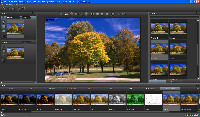
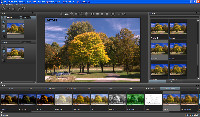 One of the Tiffen glass filters that I love to use is a polarizing filter because, depending on the angle of the sun and the direction I point the camera, a polarizing filter can turn a wimpy light-blue sky to a beautiful dark blue that more accurately represents what your eyes saw. I expected not to be very impressed with the Dfx "polarizing" filter, applied after the fact. I was wrong.
One of the Tiffen glass filters that I love to use is a polarizing filter because, depending on the angle of the sun and the direction I point the camera, a polarizing filter can turn a wimpy light-blue sky to a beautiful dark blue that more accurately represents what your eyes saw. I expected not to be very impressed with the Dfx "polarizing" filter, applied after the fact. I was wrong.
At left above is the original image. At right above, I've applied the polarizing filter and the sky is much improved.
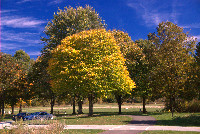
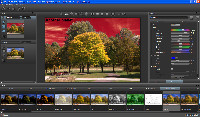 See the full-size polarized image at the left. But these digital filters do things that glass filters could never do. At the right is a modified polarizing image that might create the view you'd see on another planet.
See the full-size polarized image at the left. But these digital filters do things that glass filters could never do. At the right is a modified polarizing image that might create the view you'd see on another planet.
Creating the kind of image at the right would be extremely difficult in a film-and-darkroom setting. In a digital age, this kind of trick is quick and easy.
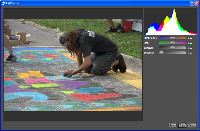
 At the left is an image that I took at last year's Via Colori. It's an OK image of an artist, but I thought that a somewhat desaturated, airy view might be better. And the image should also be cropped a bit to eliminate the extraneous feet.
At the left is an image that I took at last year's Via Colori. It's an OK image of an artist, but I thought that a somewhat desaturated, airy view might be better. And the image should also be cropped a bit to eliminate the extraneous feet.
The result is the image at the right.
The desaturation and fog effects are subtle, but I like the result of using them.
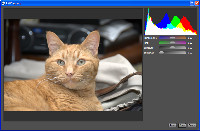 I am owned by an orange cat. That's him at the left. This view also shows the input screen that Dfx provides for raw images. At this point, I can modify the color balance, the tint, the exposure, and the black level.
I am owned by an orange cat. That's him at the left. This view also shows the input screen that Dfx provides for raw images. At this point, I can modify the color balance, the tint, the exposure, and the black level.
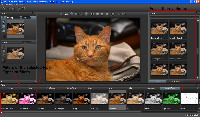 The orange cat, Tangerine, is actually more orange than he looks in the image at the left, so I selected Special Effects, Enhancing, and the Enhancing Red 5 preset.
The orange cat, Tangerine, is actually more orange than he looks in the image at the left, so I selected Special Effects, Enhancing, and the Enhancing Red 5 preset.
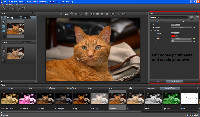 In addition to the presets, Tiffen Dfx allows the user to specify settings.
In addition to the presets, Tiffen Dfx allows the user to specify settings.
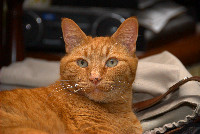 So I can create an image that represents my very orange cat as a very orange cat. The image is more accurate than the one the camera recorded.
So I can create an image that represents my very orange cat as a very orange cat. The image is more accurate than the one the camera recorded.
Hollywood producers sometimes need night scenes, but trying to photograph any scene at night is between difficult and impossible. Instead, cinematographers have developed techniques that allow them to shoot during the day, modify the exposure and the color balance, and make the image appear to have been shot at night.
 That's what I wanted to do with the image of a flamingo that I took at the Columbus Zoo. The image was created inside a building, during the day, and with supplemental flash to fill in the shadowed areas. The Tiffen "Day for Night" filter produced the kind of image that would easily pass for a night view of the flamingo.
That's what I wanted to do with the image of a flamingo that I took at the Columbus Zoo. The image was created inside a building, during the day, and with supplemental flash to fill in the shadowed areas. The Tiffen "Day for Night" filter produced the kind of image that would easily pass for a night view of the flamingo.
 Bottom Line: Tiffen understands photography, so Dfx is a tool that every professional will need and every amateur will want.
Bottom Line: Tiffen understands photography, so Dfx is a tool that every professional will need and every amateur will want.
If Dfx could preview raw images and save intermediate images as DNG or PSD files instead of TIFF images, it would earn 5 cats. Even so, Dfx packs a lot of power into a package that can cost as little as $100.
For more information, visit the Tiffen Dfx website.
Stupid Spam of the Week
I haven't dissected a stupid spam of the week for a while, so this seemed to be a good time to cast a jaundiced eye on a message from the "United Parcel Service of America", which appears to be a conflation of "United Parcel Service" and the "United States Postal Service". The instant I saw the message in my spam catcher, I knew it was a fraud for several reasons: I hadn't sent any UPS packages recently, the message's claimed return address was "shielslaw.com" instead of either usps.com (the postal service) or ups.com (United Parcel Service), and the "tracking number" began with a "V" when everyone knows that all UPS tracking numbers begin with "Z". C'mon guys, try to make it a little more challenging than this!
![]() Messages from UPS do not come from "Cornell Gilbert", whose name and e-mail address appear to have been misappropriated by spammers. Neither Cornell nor "shielslaw.com" (assuming it existed, which it appears not to) were involved in the spam attack.
Messages from UPS do not come from "Cornell Gilbert", whose name and e-mail address appear to have been misappropriated by spammers. Neither Cornell nor "shielslaw.com" (assuming it existed, which it appears not to) were involved in the spam attack.
 I cautiously opened the message in my spam catcher. The address is wrong. I haven't used bill.blinn@techbyter.com for 3 years. Additionally, I suspect that UPS would not begin a message with "Dear customer!" UPS, when it sends advisories, provides links to its website, not zip files. And if I'm supposed to collect the package "at our office", I think UPS would tell me which office. The United States is a large country with a lot of UPS offices. But I already knew this was a fraud.
I cautiously opened the message in my spam catcher. The address is wrong. I haven't used bill.blinn@techbyter.com for 3 years. Additionally, I suspect that UPS would not begin a message with "Dear customer!" UPS, when it sends advisories, provides links to its website, not zip files. And if I'm supposed to collect the package "at our office", I think UPS would tell me which office. The United States is a large country with a lot of UPS offices. But I already knew this was a fraud.
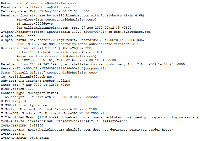 So now let's take a look at the message's routing headers to see where it came from. The message originated at IP address 218.74.247.149, which is in China, and was routed via redcondor.net, which is in Rohnert Park, California. Red Condor might be an innocent victim or a willing collaborator.
So now let's take a look at the message's routing headers to see where it came from. The message originated at IP address 218.74.247.149, which is in China, and was routed via redcondor.net, which is in Rohnert Park, California. Red Condor might be an innocent victim or a willing collaborator.
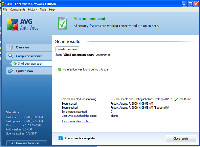 The attachment is a zip file, so let's see what AVG Antivirus thinks of it. The zip file itself isn't seen as harmful. But what's inside the zip file? That's the next question.
The attachment is a zip file, so let's see what AVG Antivirus thinks of it. The zip file itself isn't seen as harmful. But what's inside the zip file? That's the next question.
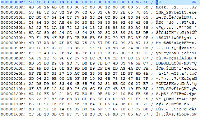 I opened the file with Ultra Edit and confirmed that it is indeed just a plain zip file. The first 2 letters in the file header ("PK") confirm this to be the case. But what about the compressed file?
I opened the file with Ultra Edit and confirmed that it is indeed just a plain zip file. The first 2 letters in the file header ("PK") confirm this to be the case. But what about the compressed file?
 Well, the compressed file is executable. If I didn't already know that the message was a fraud, this would seal its fate. UPS doesn't send executable files. If I would run this file, it would attempt to install malware on my computer.
Well, the compressed file is executable. If I didn't already know that the message was a fraud, this would seal its fate. UPS doesn't send executable files. If I would run this file, it would attempt to install malware on my computer.
![]() Instead, I decided to delete the file. This is exactly what you should do if you receive an unexpected message that claims a package you never sent couldn't be delivered to someone you don't know.
Instead, I decided to delete the file. This is exactly what you should do if you receive an unexpected message that claims a package you never sent couldn't be delivered to someone you don't know.
Cats and Brains
This week one of our cats died. Actually, he was euthanized. He had been diagnosed, a couple of weeks ago, with FIP (feline infectious peritonitis). Thin before, now he was clearly failing. One eye had filled with blood and the other was starting to. He ate a little and slept a lot. So it was time. Hermes was one of my older daughter's 4 cats who are currently living here with our 3 cats. He had adopted my wife and was her constant companion. But now we could give him only one thing, a good death. The technological link is a bit weak, but I think this is something you'll find interesting.
When I'm at the gym, I've been listening to an audio book, "My Stroke of Insight" by Jill Bolte Taylor, a brain scientist who survived a stroke. In the early chapters, she explained a bit of brain anatomy and made the case that we are not "thinking animals with feelings" but "feeling animals who think". In that regard, I think we're a lot closer to cats and dogs than we might like to believe.
http://www.ted.com/index.php/talks/jill_bolte_taylor_s_powerful_stroke_of_insight.html
(This video is worth watching. The book, My Stroke of Insight, is worth reading or listening to.)
Cats, too, are feeling beings. They may not "think" the way we like to think that we think, but the cats understand that something has changed. Some of them have become increasingly needy these past few days, wanting to sit with a human. This will pass, as it has when we have seen it with other cats following the death of a member of the herd.
These themes of cats' emotional responses and recovering from a stroke coincide in surprising ways.
Having survived a stroke that destroyed or damaged much of her brain's left hemisphere (logic, speech, linear thought) and having taught herself to recover her life primarily using the right hemisphere (pictures), Jill Taylor makes a strong case (stronger in the book and audio book than on the video I've linked to) for allowing our left brain to tell our right brain how we will respond to the world.
Dr. Taylor had the "luxury" of having to re-learn nearly everything and says that she consciously chose to eliminate anger and other negative emotions. This has nothing to do with cats, but it has everything to do with the way we live our lives: http://www.mystrokeofinsight.com/
Or maybe it does have something to do with cats. Cats can be ferocious one instant, when the fight/flight response sets in, but they can be relaxed and purring moments later.
Maybe cats can't "think" the way we think we humans think, but maybe they're smarter than humans, or at least intelligent in a different way. Dogs, too, by the way; but I have more experience with cats.
In any event, I thank Hermes for the time he gave us. http://www.blinn.com/hermes/.
Short Circuits
Microsoft Office for the Mac will have Outlook
If you have a Mac and you use all of Microsoft Office 2008's components, your e-mail application is called Entourage. In the next version of Office for the Mac, Entourage will be gone. In its place will be a Mac version of Outlook. The advantage of the change, according to Microsoft, is that the same e-mail and organization application will run on both platforms.
When? No date has yet been announced, but the next Windows version of Office will be Office 2010, which will ship next year. Typically the Mac version of the suite ships a year later: For example, Office 2007 for Windows and Office 2008 for the Mac. If that holds true, expect it in 2011.
This week Microsoft released a new version of Entourage that does a better job of synching tasks, notes, and categories with other applications. This is seen as an interim step between versions.
One possible, but unlikely, roadblock might be a court ruling this week in which a judge banned Microsoft from selling Microsoft Word, an important component of Office, because of an alleged patent violation. Microsoft has 60 days to appeal the decision. There will be a settlement of some sort, of course -- no doubt about that. Office is too important to Microsoft's fiscal well being.
Texas Judge Orders Microsoft to Stop Selling Word
Why Texas? Microsoft is, of course, a Redmond, Washington, company. The Canadian company that filed suit against Microsoft, claiming patent infringement, is headquartered in Toronto. The suit might have been filed in Michigan or Ohio district court (close to Toronto) or in Washington (Microsoft's home state). Instead I4i selected the federal district court at 211 W. Ferguson Street in Tyler, Texas. Tyler, a bustling metropolis of about 85,000 people, is 100 miles southeast of Dallas. Maybe I4i selected the venue because of the pleasant east Texas summer climate. Or maybe there was another reason.
The US District Court for the Eastern Division of Texas is well known as a place where small companies can file large lawsuits against big companies and win. And Judge Leonard Davis didn't disappoint.
Judge Davis ordered Microsoft to stop selling and supporting Microsoft Word. In addition to Microsoft, companies such as Apple and Sony have been dragged into court in this district and have lost. Specifically, this ruling prohibits Microsoft from selling any "Infringing and Future Word Products that have the capability of opening a .XML, .DOCX or .DOCM file ('an XML file') containing custom XML." It applies to both Word 2003 and Word 2007.
I4i might want to settle quickly with Microsoft because the US Patent and Trademark Office issued a patent to Microsoft earlier this month for a "word-processing document stored in a single XML file that may be manipulated by applications that understand XML." That could blow I4i's case out of court.
More than 400 copyright, patent, and trademark cases were filed in the US District Court for Eastern Texas in 2007. In the same year, fewer than 800 such cases were brought in all US District Courts in New York state.


 The author's image: It's that photo over at the right. This explains why TechByter Worldwide was never on television, doesn't it?
The author's image: It's that photo over at the right. This explains why TechByter Worldwide was never on television, doesn't it?
